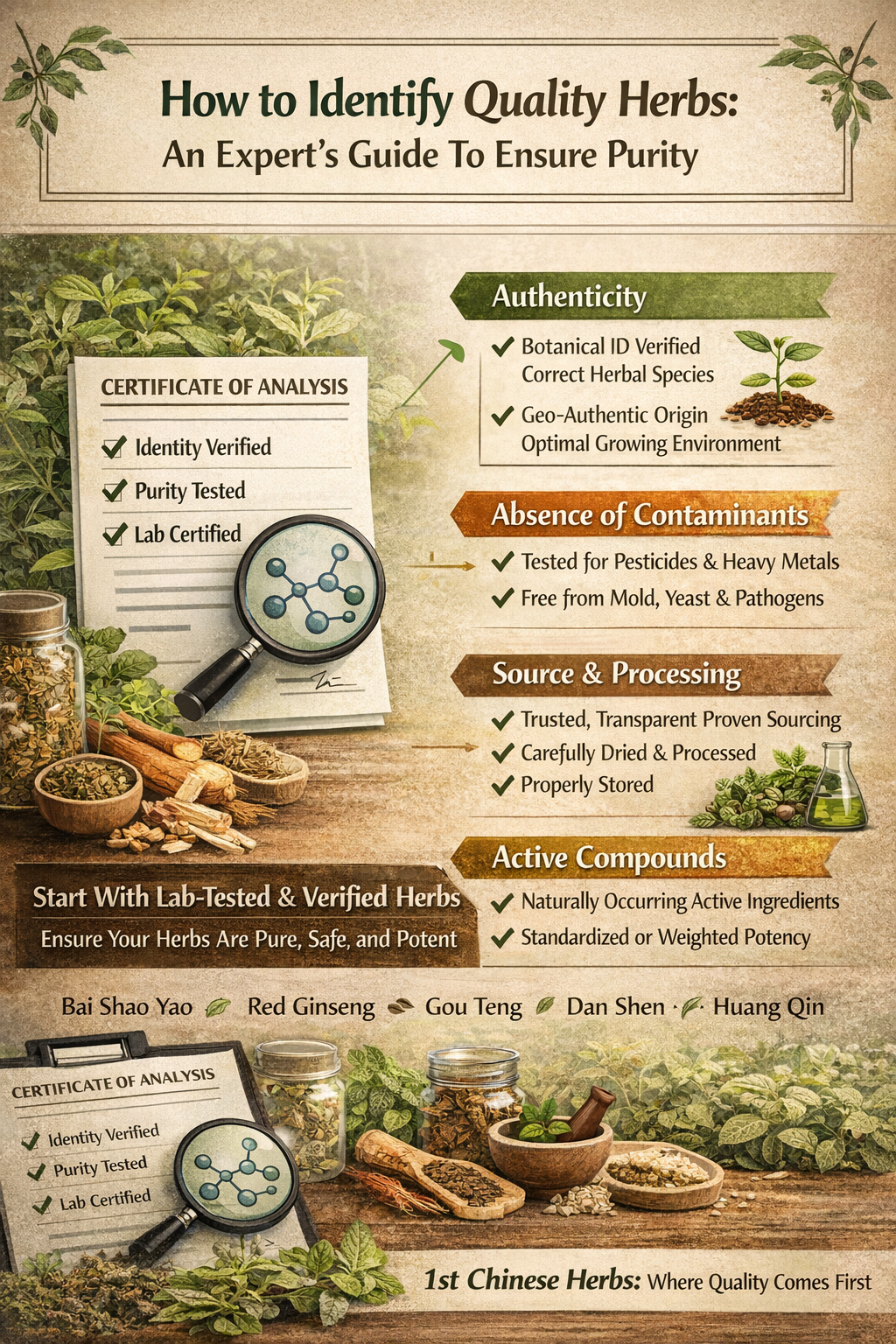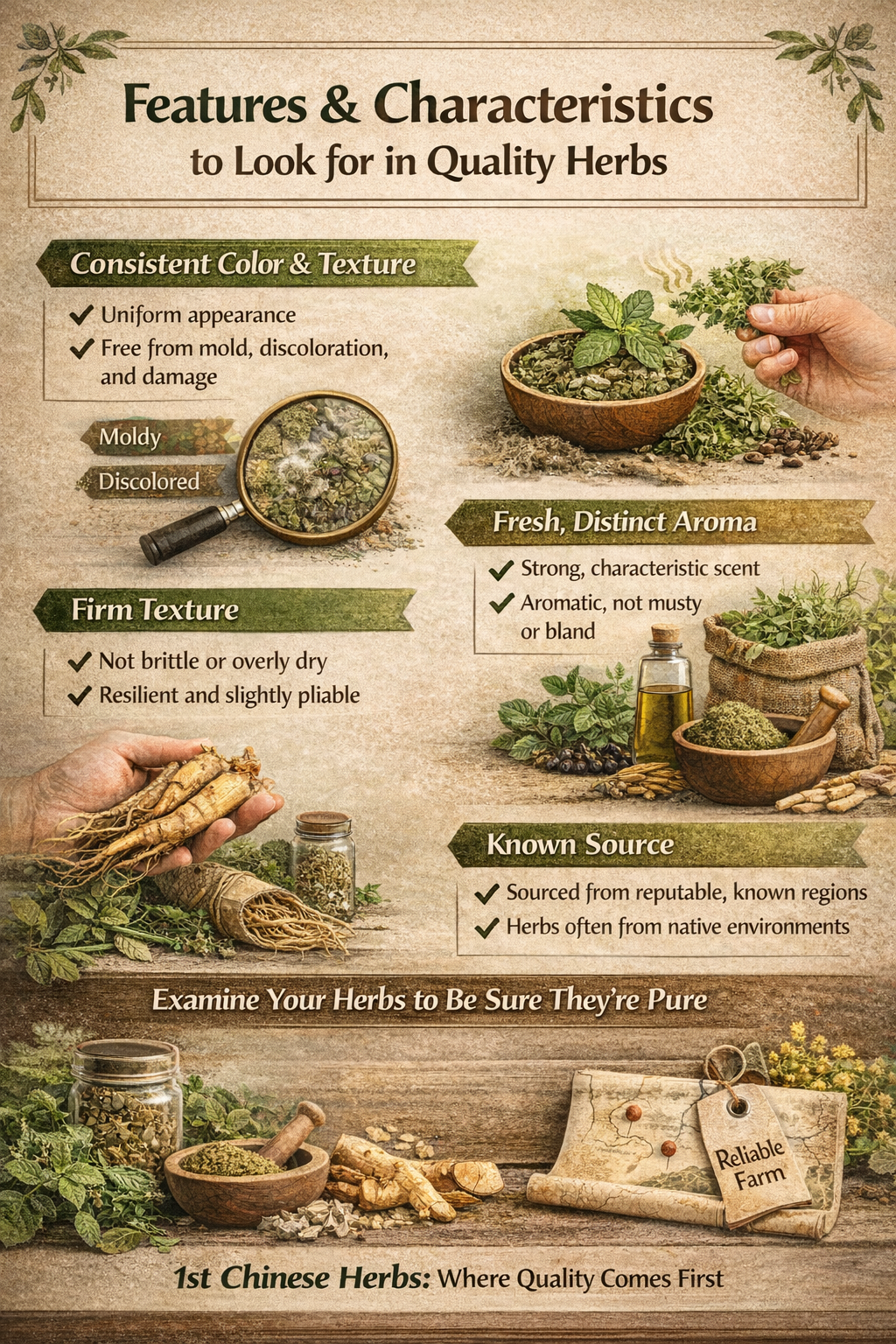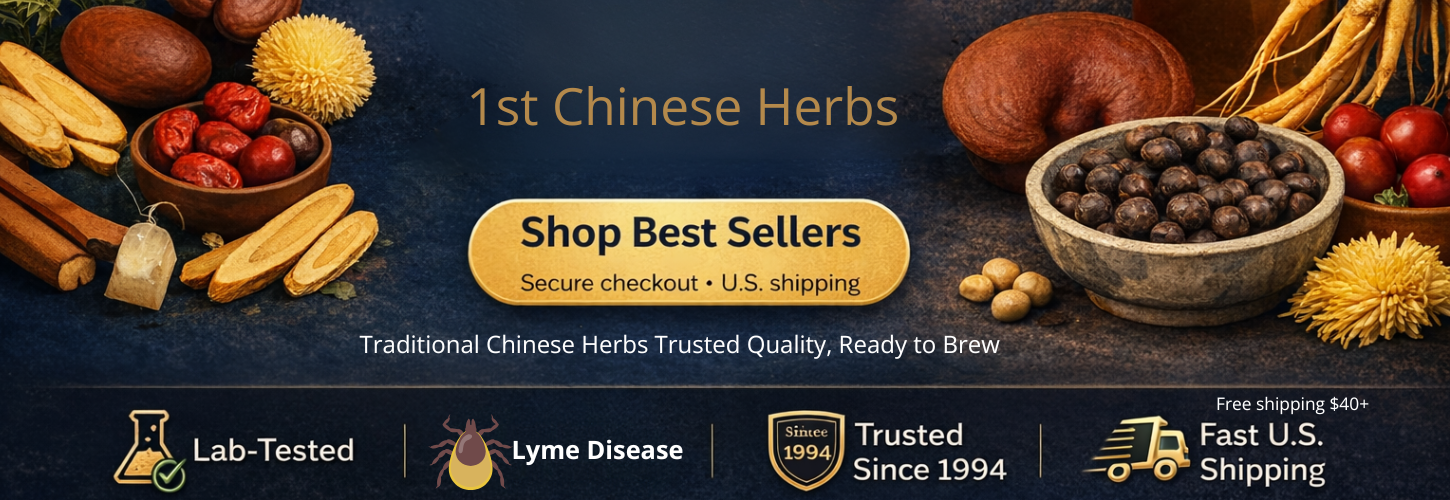How to Identify Quality Herbs: An Expert's Guide
In the world of herbal medicine, the quality of herbs is paramount. Ensuring that you are using high-quality herbs can significantly impact the effectiveness of your remedies. This guide will help you identify quality herbs and understand the importance of a Certificate of Analysis (COA). We'll also discuss the features and characteristics to look for using examples like Bai Shao Yao, Red Ginseng, Gou Teng, Dan Shen, and Huang Qin. At 1st Chinese Herbs, we are committed to offering only the highest quality and purity of all the herbs we sell.

What is a Certificate of Analysis? The Importance of a COA
A Certificate of Analysis (COA) is a crucial document provided by a third-party laboratory that verifies the quality and purity of the herb. This certificate includes detailed information about the herb's composition, confirming its authenticity, purity, and concentration of active ingredients.
How a Certificate of Analysis Confirms Herb Authenticity
A COA plays a pivotal role in confirming the authenticity of herbs. Authenticity is crucial for ensuring that the herbs you are using are exactly what they claim to be and possess the desired therapeutic properties. Here’s how a COA helps in confirming the authenticity of herbs:
Botanical Verification
A COA includes the botanical name of the herb, which is verified against established scientific criteria. This ensures that the herb is correctly identified at a species level, eliminating the risk of misidentification. Microscopic examination of the herb's structural components can reveal unique cellular structures and patterns characteristic of the specific herb.
Chemical Fingerprinting
A COA often includes a chemical fingerprint of the herb, identifying and quantifying specific active compounds. Each herb has a unique chemical profile that can be matched against reference standards to confirm its identity. Certain herbs are known for containing specific marker compounds, and a COA will list these compounds and their concentrations, verifying that the herb has the right chemical composition.
DNA Barcoding
Advanced COAs may use DNA barcoding to authenticate herbs. This involves extracting DNA from the herb and comparing it to known genetic sequences for the species, providing a highly accurate means of identification.
Purity and Contaminant Testing
A COA checks for the presence of adulterants and contaminants such as pesticides, heavy metals, and microorganisms. The absence of these contaminants supports the herb's authenticity, as genuine, high-quality herbs are less likely to be contaminated.
Source Verification
A COA often includes information about the herb's source, such as the geographic location where it was grown. Authentic herbs are typically sourced from specific regions known for their quality and purity. Details about the harvesting and processing methods can also be included in the COA, ensuring the herb's integrity and potency are preserved.
Ensuring Purity in Herbs
Purity in herbal medicine means the absence of unwanted substances that can compromise the herb's quality and safety. Ensuring the purity of herbs involves careful sourcing, rigorous testing, and adherence to best practices in cultivation and processing.
Careful Sourcing
High-quality herbs are sourced from trusted suppliers who follow stringent quality standards. At 1st Chinese Herbs, we work with growers who practice sustainable and ethical farming, ensuring that our herbs are free from contaminants. Herbs sourced from their native regions or areas known for their optimal growing conditions are often purer.
Rigorous Testing
Herbs are tested for heavy metals, pesticide residues, and harmful microorganisms. Detailed chemical analyses identify and quantify the active compounds in the herb, ensuring the exact concentration of these compounds. Batch testing ensures that each batch of herbs meets specified concentration levels, maintaining the efficacy of the herbal products.
Adherence to Best Practices
Utilizing organic farming practices reduces the risk of contamination from synthetic chemicals. Proper harvesting methods and processing techniques help maintain the purity of herbs, including washing, drying, and packaging in clean, controlled environments. Proper storage conditions are essential for maintaining herb purity, preventing the growth of mold and the accumulation of contaminants.
The Role of Concentration in Herbal Quality
Concentration in herbal medicine pertains to the amount of active ingredients or bioactive compounds in the herb. These compounds, such as alkaloids, flavonoids, terpenoids, and glycosides, give the herb its medicinal properties. The concentration of these compounds can significantly influence the herb's efficacy and the dosage required to achieve the desired therapeutic effects.
Optimal Cultivation Practices
Growing herbs in their native environments or regions with optimal soil and climate conditions helps achieve higher concentrations of active compounds. The timing of harvest is crucial for maximizing the concentration of active compounds, with herbs harvested at the peak of their growing cycle.
Standardization
Standardization involves adjusting the concentration of active compounds to ensure consistent potency across different batches of the same herb. This can be achieved through blending or extracting specific compounds to meet a set standard. Strict quality control measures during processing help maintain the desired concentration of active compounds.
Proper Processing and Storage
Utilizing appropriate extraction methods, such as water or alcohol extraction, helps in preserving and concentrating the active compounds in the herb. Proper storage conditions are essential for maintaining the concentration of active compounds, preventing degradation and loss of potency.
Why Purity and Concentration Matter
Purity and concentration are critical for ensuring the efficacy, safety, and consistency of herbal remedies. Pure herbs retain their natural active compounds at optimal levels, providing the intended therapeutic effects. Accurate concentration measurements help determine the correct dosage, minimizing the risk of side effects or toxicity. Consistent concentration across different batches guarantees that each dose provides the same therapeutic benefits. Herbs with higher concentrations of active compounds often require smaller dosages, making them more cost-effective for long-term use.
 Features and Characteristics to Look For in Quality Herbs
Features and Characteristics to Look For in Quality Herbs
When identifying quality herbs, several features and characteristics can help you distinguish the best from the rest. High-quality herbs should have a consistent color and texture, free from mold, discoloration, and other signs of deterioration. Fresh herbs typically have a strong, distinct aroma. The herb's texture should be firm and resilient, not brittle or overly dry. Knowing the source of the herbs is crucial, as herbs grown in their native environments often have better medicinal properties.
Examples of Quality Herbs
Bai Shao Yao (White Peony Root): Should be white to off-white with a smooth texture and minimal cracks. Fresh Bai Shao Yao has a mildly sweet, earthy scent and should be firm and slightly flexible.
Red Ginseng (Hong Shen): A reddish-brown color with a slightly glossy surface. It has a strong, sweet, and slightly bitter smell and should be firm and slightly sticky.
Gou Teng (Uncaria): Should have a greenish-brown color with visible hooks. It has a mild, earthy scent and should be firm and flexible.
Dan Shen (Salvia Miltiorrhiza): A reddish-brown root with a slightly rough texture. It has a strong, aromatic scent similar to eucalyptus and should be firm and woody.
Huang Qin (Baical Skullcap Root): Yellowish-brown with a smooth, clean surface. It has a slightly bitter, earthy smell and should be firm and dry.
Why Choose 1st Chinese Herbs?
At 1st Chinese Herbs, we prioritize the quality and purity of our products. Every batch of herbs is rigorously tested for contaminants and potency, meeting the highest standards of purity and effectiveness. We source our herbs from trusted suppliers who practice sustainable and ethical farming, ensuring quality and supporting the environment. We provide detailed information about the source and quality of our herbs, including COAs for each product, allowing you to make informed decisions. Our knowledgeable staff is always available to answer your questions and help you find the right herbs for your needs.
The Difference Between High Quality and Low Quality Herbs
In the realm of herbal medicine, the distinction between high quality and low quality herbs is crucial. The quality of herbs directly impacts their efficacy, safety, and overall therapeutic benefits. High quality herbs meet stringent standards of purity, potency, and safety. They are correctly identified and verified as the specific herb they claim to be, free from contaminants, and contain optimal levels of active compounds. They have a consistent color and texture, a strong aroma and flavor, and are often sourced from their native environments. High quality herbs come with a Certificate of Analysis (COA) that verifies their authenticity, purity, and potency.
Low quality herbs, on the other hand, often fail to meet the standards necessary for effective and safe use. They may be misidentified, contain harmful contaminants, and have lower levels of active compounds. Their appearance may show signs of mold, discoloration, or other deterioration, and they may have little to no aroma or flavor. The origins of low quality herbs are often unclear, and they may lack proper documentation, making it difficult to ascertain their purity, potency, and authenticity.
At 1st Chinese Herbs, we are dedicated to providing only the highest quality herbs. We ensure that our products meet stringent standards of purity, potency, and authenticity, giving you confidence in the herbs you use. By choosing high quality herbs, you can maximize the benefits of your herbal remedies and ensure the well-being of those who rely on them.

